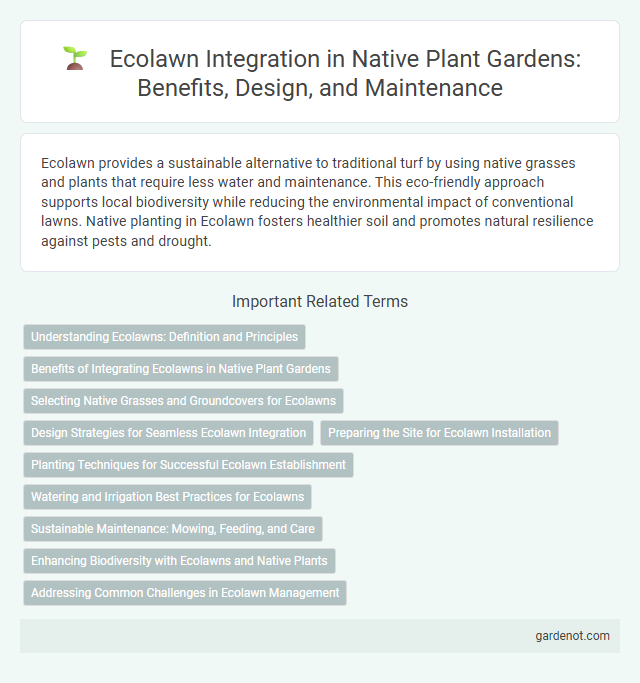Ecolawn provides a sustainable alternative to traditional turf by using native grasses and plants that require less water and maintenance. This eco-friendly approach supports local biodiversity while reducing the environmental impact of conventional lawns. Native planting in Ecolawn fosters healthier soil and promotes natural resilience against pests and drought.
Understanding Ecolawns: Definition and Principles
Ecolawn is a sustainable landscaping approach that uses native grasses and plants to create low-maintenance, drought-resistant lawns. It emphasizes biodiversity, soil health, and minimal irrigation, reducing the need for fertilizers and pesticides. Designed to support local ecosystems, ecolawns promote natural resilience and environmental benefits.
Benefits of Integrating Ecolawns in Native Plant Gardens
Ecolawns enhance native plant gardens by reducing water consumption and minimizing chemical fertilizer use, promoting a sustainable landscape. Their deep-rooted, drought-tolerant grasses improve soil health and support local biodiversity, creating a resilient ecosystem. Integrating ecolawns also lowers maintenance demands, offering an eco-friendly alternative to traditional lawns that complements native flora.
Selecting Native Grasses and Groundcovers for Ecolawns
Selecting native grasses and groundcovers for ecolawns enhances drought tolerance, soil health, and local biodiversity. Species like Buffalo grass (Bouteloua dactyloides) and Creeping Blue Stem (Schizachyrium scoparium) offer low-maintenance, climate-adapted options that reduce watering and mowing needs. Incorporating native groundcovers such as Bearberry (Arctostaphylos uva-ursi) supports pollinators and prevents erosion, creating resilient, eco-friendly lawn alternatives.
Design Strategies for Seamless Ecolawn Integration
Ecolawn design strategies emphasize selecting native grass species that complement local ecosystems, enhancing biodiversity while maintaining aesthetic appeal. Integrating pollinator-friendly plants and layering native wildflowers aids in creating a seamless transition between traditional turf and natural landscapes. Proper soil preparation and adaptive mowing techniques ensure resilient, low-maintenance ecolawn areas that support sustainable urban environments.
Preparing the Site for Ecolawn Installation
Proper site preparation is crucial for successful Ecolawn installation, involving thorough soil testing and removal of existing vegetation to ensure optimal root development. Loosening the soil to a depth of at least 4 inches improves aeration and water infiltration, promoting healthy growth of native grasses. Applying a balanced organic fertilizer tailored to native species supports nutrient availability during the establishment phase.
Planting Techniques for Successful Ecolawn Establishment
Ecolawn establishment requires precise soil preparation, including aeration and the removal of existing vegetation to promote healthy root growth. Selecting drought-tolerant, native grass species such as fine fescues ensures compatibility with local ecosystems and reduces maintenance needs. Consistent watering during the initial weeks supports seed germination, while avoiding overwatering minimizes fungal diseases and promotes robust, sustainable Ecolawn development.
Watering and Irrigation Best Practices for Ecolawns
Ecolawns thrive with infrequent, deep watering that encourages deep root growth and drought tolerance. Irrigation should be scheduled early in the morning to minimize evaporation and maximize water absorption. Using drip irrigation or soaker hoses ensures efficient water delivery directly to the soil, reducing runoff and promoting healthy native grass development.
Sustainable Maintenance: Mowing, Feeding, and Care
Ecolawn offers sustainable maintenance by requiring minimal mowing, which reduces fuel consumption and carbon emissions. Its natural blend of drought-tolerant grass species limits the need for synthetic fertilizers, promoting healthier soil ecosystems. Regular care involves aeration and overseeding, supporting long-term lawn resilience and biodiversity.
Enhancing Biodiversity with Ecolawns and Native Plants
Ecolawns integrate native plants to create resilient, low-maintenance turf that supports local wildlife and pollinators. By using species adapted to regional conditions, ecolawns increase plant diversity while reducing water and chemical inputs. These sustainable lawns foster vibrant ecosystems, promoting habitat connectivity and ecological balance in urban and suburban areas.
Addressing Common Challenges in Ecolawn Management
Ecolawn management often faces challenges such as soil compaction, improper irrigation, and weed invasion that can hinder native plant growth. Implementing aeration techniques, optimizing watering schedules based on local precipitation, and using organic mulches can enhance soil health and promote robust Ecolawn establishment. Regular monitoring for invasive species and timely manual removal help maintain biodiversity and support native ecosystems within Ecolawn landscapes.
Ecolawn Infographic

 gardenot.com
gardenot.com